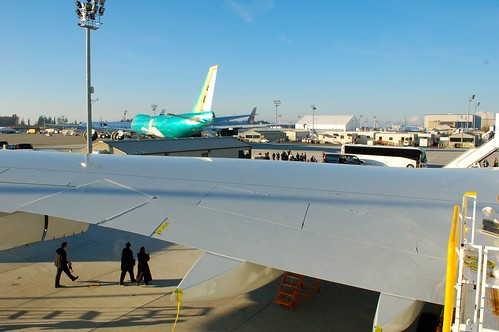

by flightblogger
Boeing is investigating an unexpected buffet in the inboard flaps of the 747-8F, a design issue that may prompt a costly redesign and put significant pressure on the flight test schedule.
The buffet was first discovered following the first flight of the 747-8F on February 8th, when the aircraft extended its flaps to the maximum setting of 30 with the landing gear fully extended, say program sources.
Two independent program sources say landings with flaps set to 30 are being avoided until the issue is addressed.
Boeing confirmed the flaps 30 buffet, saying: "It is a discovery we are addressing. We expect to have discoveries during the tests and we then address them in due course. This is the nature of testing. It is the fundamental reason why we conduct a thorough flight-test program. You find issues and resolve them."
ShareCreateApture


by flightblogger
The buffet, which has been described as "very apparent", has been traced to disruptive air flow coming off of the
outboard landing gear doors.
Boeing ruled out a problem unique to RC501, the first 747-8F, as the same flap buffet was duplicated on RC522's March 15th first flight.
The second 747-8F test aircraft, RC521- the third to fly - made its maiden flight on March 17th.
The flaps on the 747-8F are one of the major aerodynamic changes incorporated into the latest version of Boeing's jumbo jet, with the
outboard flaps single-slotted and
inboard double-slotted.
By comparison, says one program source, the 747-400's flaps were
triple-slotted allowing turbulent air to pass through; however, the single and double-slotted flaps provide "a lot more surface to cause a turbulent layer to form".
Unexpected structural buffet on aircraft surfaces can be common during flight testing, though the solution may vary from vortex generators to redirect the airflow or even a complete re-design of the disruptive part.
During the 777's flight test program in 1994, Boeing found the 777 discovered the aircraft's nose landing gear doors
buffeted wildly when opening and closing at speed, prompting the installation of metal baffles in the nose landing gear well to redirect the airflow.
Boeing has devoted one of the three 747-8F test aircraft to addressing the flap buffet.
On March 22nd Boeing began flying RC522 with the
outboard landing gear doors removed to assess the impact at the flaps 30 setting. The early flight tests confirmed that the source of the buffet was disruptive air flow from the landing gear doors. On March 23rd, RC522
flew with the upper portion of the outboard gear door re-attached.
Boeing is considering several solutions to the problem. One option involves reducing the flap extension to from 30 to 27. However, decreasing the maximum flap setting could raise the landing speed of the 747-8.
ShareCreateApture


by flightblogger
The airframer has ruled out installing vortex generators on the inboard flaps to redirect the airflow, program sources say. The over-wing emergency escape slides on the 747-8I passenger variant could tear on the vortex generators.
The final impact of the 747-8F flap buffet is yet unclear. Sources say that without a final low-speed configuration, the aircraft cannot conduct community noise evaluations.
While RC522 is assigned to resolve the flaps 30 buffet, RC501 conducted variable center of gravity stalls. RC521 remains in post-first flight layup at Boeing Field.
Boeing is targeting the fourth quarter for certification and first delivery of the 747-8F to Luxembourg-based Cargolux, following a 1,600h flight test period and 2,100h of ground testing.







 by flightblogger
by flightblogger



